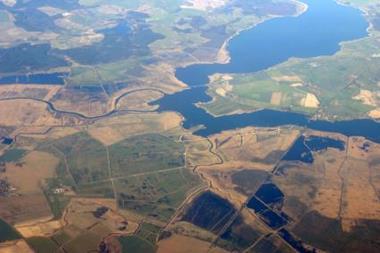By Professor Bill McGuire of Aon Benfield UCL Hazard Research Centre
The impact of a string of powerful storms, most notably Gustav, Hanna and Ike, dominated the period of the report, which spans the second half of the ‘official’ Atlantic hurricane season. For the 2008 Atlantic hurricane season in its entirety, economic losses stand at $52 billion, making it the second most destructive on record.
In terms of loss of life, Haiti was worst affected, with consecutive hits from Tropical Storm Fay, followed by Gustav, Hanna and Ike, resulting in over 800 deaths, including 537 during Hanna’s passage. Gustav and Ike were the most destructive storms, with their respective US landfalls in Louisiana and Texas causing damage totalling $42 billion. Insured losses for the two storms have been estimated at $13-21 billion for Ike and $2 – 4.5 billion for Gustav.
Hurricane Paloma came as a bit of a shock late on in the season. The 17th named storm and the fifth major hurricane of the 2008 season, Paloma was particularly short lived. It reached Category 4 strength but then dissipated in just five days. The Cayman Islands and Cuba bore the brunt of the storm, causing an estimated $1.4 billion worth of damage in the latter.
The period was also characterised by several episodes of severe flooding, most notably associated with the South Asian Monsoon. In India, 2.4 million people were marooned by floods in the state of Bihar, with similar numbers affected in Bangladesh. Destructive and lethal floods also affected Central Europe, Pakistan, Vietnam Thailand and parts of eastern Africa. Geologically, the period was quiet, although moderate earthquakes did take lives in Kyrgyzstan and Pakistan. In California, wildfires continued to be a problem, burning large areas and triggering the largest evacuation in the state’s history.
Territory: Caribbean, United States
Region: Turks and Caicos Islands, Bahamas, Haiti, Dominican Republic, Cuba, Florida Keys, Mississippi, Louisiana, Texas, Mississippi Valley, Ohio Valley, Great Lakes region
Date: 1 – 16 September
Event: Hurricane Ike
Impact: After Katrina (2005) and Andrew (1992), Hurricane Ike was the costliest hurricane to make landfall in the United States. Total economic losses for the storm are estimated at $31.5 billion, with $4 billion incurred in Cuba and the balance in the United States. RMS estimates insured losses (onshore and offshore together) at somewhere between $13 and $21 billion. Deaths arising from Ike totalled at least 162, including 74 confirmed dead in Haiti and 82 in the United States. In the Turks and Caicos Islands, almost every building was damaged on Grand Turk Island and South Caicos, while power was lost across Grand Turk.
In Haiti, Ike contributed towards a figure of 1 million homeless, arising from the combined effects of storms Hanna, Fay, Gustav and Ike. Over 2.5 million people were evacuated in Cuba, where a 12 metre storm surge destroyed 200 properties and wind and rain devastated the sugar-cane crop. The death toll in Galveston and associated communities was limited by mandatory evacuation, and considering the widespread flooding of central Galveston could have been far higher. Damage was also caused in Houston by high winds, while up to 4.5 million people across the state of Texas lost access to power.
Summary: Ike formed at the end of August, from a tropical disturbance close to the Cape Verde Islands. On 1 September it achieved tropical storm status, to the west of the Cape Verdes, and four days later was a Category 4 storm and the most powerful hurricane of the season. With hurricane-force winds stretching out to nearly 400km, Ike was also, at one point, the biggest Atlantic hurricane ever recorded, with the greatest storm-surge destructive potential. Two days later, on the 7th, Ike had weakened to a Category 2 storm prior to passing directly over the Turks & Caicos Islands, which were battered by 215kmh winds. Following intensification to Category 3, Ike made landfall on Cuba’s north coast later the same day, and travelled the length of the island before entering the Gulf of Mexico on the 9th. On the 13th, Ike made landfall at Galveston, Texas as a Category 2 storm, with maximum sustained wind speeds of 175kmh. The storm was still very wide, with hurricane force winds stretching out to nearly 200km from the centre. Ike weakened to a tropical storm and then a tropical depression as it tracked north past Dallas and inland to Little Rock, Arkansas, St. Louis, Missouri, through the Mid-West and, eventually, into Canada, bringing heavy rains along the way.
Data sources: Houston Business Journal
http://houston.bizjournals.com
ReliefWeb
www.reliefweb.int
Additional sources: Wikipedia
Territory: Caribbean and United States
Region: Dominican Republic, Haiti, Jamaica, Cayman Islands, Cuba, Florida, Louisiana, Mississippi, Alabama, Arkansas
Date: 25 August to 4 September
Event: Hurricane Gustav was the second major hurricane of the 2008 season and the fourth costliest. In Haiti, the storm took 76 lives and destroyed more than 2,000 homes. In Jamaica, it resulted in 11 deaths and caused damage totalling an estimated $42 million to the country’s road system. Cuba evacuated 300,000 people prior to Gustav’s arrival, and sustained the worst storm damage since 1956 due to gusts of up to 341kmh. This included close to 120,000 houses damaged and 32,000 acres of crops destroyed. In Louisiana, the death toll of 43 would have been much higher without prior evacuation of 2 million people. Damage was, however, extensive, especially to central Louisiana, and parts of Mississippi, Alabama and the Florida panhandle. In New Orleans, the storm surge topped flood walls but was kept at bay by new splash guards. Fears of major damage resulted in almost all the oil production in the Gulf being shut down before the storm’s arrival. Losses are estimated to be $15 billion in the United States and a further $3 billion in Cuba. The final death toll was 138.
Summary: Gustav formed on 25 August, 420km southeast of Haiti and rapidly strengthened into a tropical storm within hours and into a hurricane early the following day (just 14 hours from tropical depression to hurricane). Later on the 26th, it made landfall in southwest Haiti near the town of Jacmel. After weakening to a tropical storm, Gustav regained hurricane strength as it moved west to Jamaica and was upgraded to a Category 3 storm as it approached Cuba on 30 August. Just before landfall, its status was again upgraded, this time to Category 4, with maximum sustained wind speeds of 240km an hour. Gustav made two brief landfalls in Cuba before heading north into the Gulf of Mexico. On 1 September, it made landfall 35km west of Grand Isle, Louisiana, as a Category 2 storm, but – with maximum sustained wind speeds of 180kmh – just below the Category 3 threshold. Within hours the storm weakened, first to a Category 1 hurricane and eventually, by the 2nd, to a tropical depression.
Data sources: Wikipedia
http://en.wikipedia.org/wiki/Hurricane_
Gustav
Centre for International Disaster Information
http://www.cidi.org/
Additional sources: ReliefWeb
www.reliefweb.int
Territory: Europe (Central and Eastern)
Region: Ukraine, Moldova, Romania, Slovakia, Hungary
Date: 22 July – early August
Event: Floods
Impact: A total of 40,000 people were evacuated across Moldova, Romania and Ukraine, with 42 deaths reported. In Ukraine, the western part of the country was worst affected, with floodwaters from the Prut and Dniestr leading to 34 deaths and the evacuation of 25,000 people. Floodwaters inundated more than 300 communities and over 9,000 homes. 680km of roads and 360 bridges were damaged, and 24,000 hectares of farmland flooded. The cost of the Ukraine flooding is estimated at $650 – 870 million. In Moldova, 1,000 homes were flooded and 4,000 people evacuated from communities close to the Prut and Nistru rivers. In Romania, close to 9,000 homes in 145 communities were flooded, more than 10,000 people evacuated and four lives lost. The floods here also damaged over 1,000km of roads and 1,488 bridges, and inundated 27,000 hectares of agricultural land.
Summary: Heavy rains and storms on 22 – 23 July led to major flooding in Central Europe and Ukraine. Worst affected were Moldova, Romania and Ukraine, in particular those areas adjacent to the Dniestr and Prut rivers. Broadly speaking, flooding affected rural areas rather than urban centres. In Romania, the floods were reported to be the worst in 40 years.
Data sources: ReliefWeb
www.reliefweb.int
World Health Organisation
http://www.euro.who.int/emergencies/fieldwork/20080730_
Additional sources: International Charter: Space and Disasters
Territory: United States
Region: Southern California
Date: Mid-late October 2008
Event: Wildfires Impact: Fires affected San Diego, San Bernardino, Los Angeles and Ventura counties. At the height of the fires, 60,000 homes in and around San Diego were threatened, resulting in the evacuation of more than 500,000 people; the largest in the history of the state. More than 300,000 acres (120,000 hectares) of land was burned, 1,500 buildings and other structures destroyed, mostly in the San Diego area, and four people killed. The fires were also highly polluting, with resulting ozone, nitrous oxides, methane and carbon dioxide degrading air quality across the region. The cost of the fires has yet to be determined, but between 1 July and 14 August, wildfire-related losses in California amounted to $285 million. This compares with average annual wildfire losses a decade ago, of just $44 million.
Summary: A combination of tinder-dry vegetation, high temperatures and strong Santa Ana winds, in excess of 100kmh hour, provided the perfect conditions for the triggering of wildfires across southern California: the worst in the state for four years. Four uncontrolled fires threatened San Diego with flames 30m high, while two major blazes – Marek and Sesnon – destroyed more than 18,000 acres in the hills and mountains north of Los Angeles.
Data sources: California Department of Forestry and Fire Protection
www.fire.ca.gov/index.php
National Interagency Fire Center
www.nifc.gov/index.html
Additional sources: Incident Information System
Territory: India
Region: Bihar
Date: 18 August to early September
Event: Monsoon floods
Impact: The floods affected more than 2.4 million people in northern Bihar. Over 120,000 people were evacuated to higher ground, but a slow response to the event left over 2 million marooned and without food or water, with many thousands of families still cut off as of mid-October. Flood waters washed away at least 800 villages and destroyed essential infrastructure, including railways, power lines and roads.
In the Supaul district alone, floodwaters destroyed over 100,000 hectares (247,000 acres) of wheat, rice and other crops, with total crop loss estimated at more than 200,000 hectares. The humanitarian crisis arising from the floods is continuing into November, with food shortages and escalating food prices leading to more than 2 million people being kept alive by food aid. Death toll estimates range from less than 200 to more than 2,000.
Summary: On 18 August, more than 150cm of monsoon rainfall resulted in the Koshi River bursting its banks in the northern Indian state of Bihar. The river drains over 60,000 square kilometres of the Himalayas in Nepal and Tibet, and flow across its alluvial fan has been artificially constrained within a man-made channel. Once the walls of the channel were breached, the floodwaters spread out unconfined across the fan, at a flow rate of up to 25,000 cubic metres a second. Within 24 hours the flood covered an area of thousands of square kilometres resulting in the worst floods in the state for more than 50 years. The river now follows a new route across the alluvial fan, 120km east of the man-made channel, resulting in more than 300km of embankments becoming redundant.
Data sources: Center for International Disaster Information
www.cidi.org/sit_rep.htm
Relief Web
www.reliefweb.int
Additional sources: Wikipedia
http://en.wikipedia.org/wiki/2008_Bihar_flood
Territory: Pakistan
Region: Baluchistan
Date: 29 October
Event: Earthquake
Impact: Despite the moderate size of the earthquake, the shallow depth of the event combined with the poor state of the building stock – mainly constructed from adobe or unreinforced masonry – resulted in serious and extensive damage and destruction. Worst affected was the district of Pishin, and the Ziarat area, where several villages were destroyed by landslides activated by the ground shaking. Media reports suggest a death toll of more than 300, but as of 5 November, the official toll stands at 155, with 375 injured. Economically, the biggest impact was to the region’s apple industry, which has suffered from the destruction of trees just before harvest time.
Summary: A Moment Magnitude 6.4 earthquake struck the Pakistan province of Baluchistan at just after 04.00h local time. The quake occurred about 60km north of the provincial capital, Quetta, and 600km southwest of the national capital, Islamabad, at the shallow depth of just 15km. Shaking was measured at VI on the Modified Mercalli Scale at Quetta, and III at the city of Kandahar, 185km away. The event was followed, 12 hours later, by a comparably sized (M=6.4) aftershock at a depth of just 10km. The Quetta area is one of high seismic hazard, and a Magnitude 7.6 earthquake here in 1935 resulted in more than 30,000 deaths. The 2008 quake occurred within a structure known as the Sulaiman fold and thrust belt, a region of sedimentary rocks compressed by the ongoing collision between the Indian and Eurasian plates, which is located 50km northeast of the area of most intense damage in 1935.
Data sources: United States Geological Survey
http://earthquake.usgs.gov
ReliefWeb
www.reliefweb.int
Additional sources: NASA Earth Observatory
http://earthobservatory.nasa.gov




















No comments yet